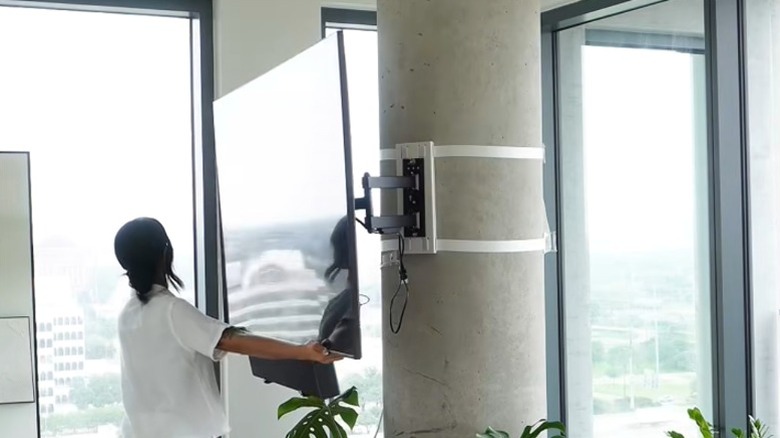What To Know Before Mounting Your TV On A Pole Or Column
We may receive a commission on purchases made from links.
Sometimes, your home presents unique challenges that are difficult to design around. Deciding where to mount your flat-screen TV is hard enough when you don't have to worry about the massive column sitting right where you want your screen to go. Years ago, you might have had to cut your losses and put the TV in an awkward, second-choice spot, but now you can use a pillar mount to affix it to that cumbersome column.
When mounting a TV to a pole or column in your home, the greatest challenge is the column's shape. Square columns offer a flat surface to work with, but round columns are not so generous. Pillar mount systems, like the CondoMounts Column TV Mount, help you circumvent the hassle associated with round columns by using a mounting plate and ratchet straps to secure the TV. Of course, drilling is still an option, but columns made of materials like concrete or metal may make that less appealing for the average homeowner. Plus, since there's no damage to the pillar from screws and lag bolts, this is a great option for renters who happen to have a column in their apartment.
Best ways to mount your TV to a pole or column
When you look at the curved surface of the round pillar interrupting your living room, you might be thinking that attaching anything to it will prove, at the very least, difficult. Rather than drilling into the pillar's surface, though, pillar mounts involve wrapping ratchet straps around it and tightening them to secure a mounting plate that you then mount your TV onto. In addition to round pillars, a pillar mounting system works for square pillars, leaving you with no holes in the surface. These no-drill mounts are, in some ways, more approachable than wall mounts that require drilling accurately and safely into studs. Plus, the ratchets are easy to tighten, loosen, and adjust. You can raise or lower the TV to any height in a few seconds, leaving you with only one question to answer — how high should you mount your TV to get the perfect view when watching?
Beyond the mounting process, you should consider the style of mount you'd like. Pillar mounts are generally either fixed, tilt, or full motion. Because of the cumbersome nature of a pillar or column, full-motion mounts are often the best fit, enabling you to extend the screen and move your TV up or down and side to side to reduce glare and optimize the view for anyone watching. And since the TV mount is able to rotate around the column as well, you gain even more unique viewing angles from multiple points around the room.
Downsides to pole or column mounting
Mounting your TV to a pole or column can flawlessly integrate the TV in your living room. Just assemble the mount, wrap the straps around the pole or column, check that it's level, and tighten it up before attaching your TV. You could even install soundbars and shelving units with similar mounts beneath the TV for a complete setup on a single column. The TV mount is easy for two people to set up and supplies a reliable hold, but it's not without its downsides. A no-drill system will leave you with straps wrapped around your pillar, which might be unsightly and difficult to hide, especially if the straps don't come in a color that matches your pillar.
Pillar mounting involves the same negative aspects as any other kind of TV mounting. You will be left with wires dangling from your TV that you will need to hide to create a seamless look. However, due to the curved surface, a round pillar can be a little less friendly to wire organizing systems like a cable raceway. The benefit of a pillar is the ability to wrap the wires horizontally around it to reach the back. But if it's visible from all sides, this doesn't solve the issue, and a pillar offers less options for camouflaging wires.


